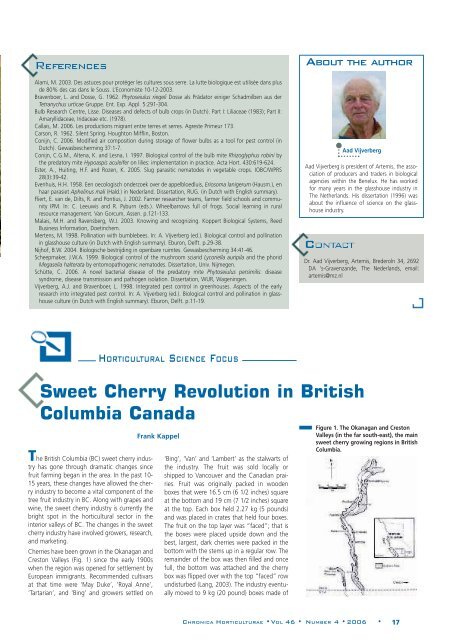Chronica - Acta Horticulturae
Chronica - Acta Horticulturae
Chronica - Acta Horticulturae
You also want an ePaper? Increase the reach of your titles
YUMPU automatically turns print PDFs into web optimized ePapers that Google loves.
REFERENCES<br />
Alami, M. 2003. Des astuces pour protéger les cultures sous serre. La lutte biologique est utilisée dans plus<br />
de 80% des cas dans le Souss. L’Economiste 10-12-2003.<br />
Bravenboer, L. and Dosse, G. 1962. Phytoseiulus riegeli Dosse als Prädator einiger Schadmilben aus der<br />
Tetranychus urticae Gruppe. Ent. Exp. Appl. 5:291-304.<br />
Bulb Research Centre, Lisse. Diseases and defects of bulb crops (in Dutch). Part I: Liliaceae (1983); Part II:<br />
Amaryllidaceae, Iridaceae etc. (1978).<br />
Callais, M. 2006. Les productions migrant entre terres et serres. Agreste Primeur 173.<br />
Carson, R. 1962. Silent Spring. Houghton Mifflin, Boston.<br />
Conijn, C. 2006. Modified air composition during storage of flower bulbs as a tool for pest control (in<br />
Dutch). Gewasbescherming 37:1-7.<br />
Conijn, C.G.M., Altena, K. and Lesna, I. 1997. Biological control of the bulb mite Rhizoglyphus robini by<br />
the predatory mite Hypoaspis aculeifer on lilies: implementation in practice. <strong>Acta</strong> Hort. 430:619-624.<br />
Ester, A., Huiting, H.F. and Rozen, K. 2005. Slug parasitic nematodes in vegetable crops. IOBC/WPRS<br />
28(3):39-42.<br />
Evenhuis, H.H. 1958. Een oecologisch onderzoek over de appelbloedluis, Eriosoma lanigerum (Hausm.), en<br />
haar parasiet Aphelinus mali (Hald.) in Nederland. Dissertation, RUG. (in Dutch with English summary).<br />
Fliert, E. van de, Dilts, R. and Pontius, J. 2002. Farmer researcher teams, farmer field schools and community<br />
IPM. In: C. Leeuwis and R. Pyburn (eds.). Wheelbarrows full of frogs. Social learning in rural<br />
resource management. Van Gorcum, Assen. p.121-133.<br />
Malais, M.H. and Ravensberg, W.J. 2003. Knowing and recognizing. Koppert Biological Systems, Reed<br />
Business Information, Doetinchem.<br />
Mertens, M. 1998. Pollination with bumblebees. In: A. Vijverberg (ed.). Biological control and pollination<br />
in glasshouse culture (in Dutch with English summary). Eburon, Delft. p.29-38.<br />
Nijhof, B.W. 2004. Biologische bestrijding in openbare ruimtes. Gewasbescherming 34:41-46.<br />
Scheepmaker, J.W.A. 1999. Biological control of the mushroom sciarid Lycoriella auripila and the phorid<br />
Megaselia halterata by entomopathogenic nematodes. Dissertation, Univ. Nijmegen.<br />
Schütte, C. 2006. A novel bacterial disease of the predatory mite Phytoseiulus persimilis: disease<br />
syndrome, disease transmission and pathogen isolation. Dissertation, WUR, Wageningen.<br />
Vijverberg, A.J. and Bravenboer, L. 1998. Integrated pest control in greenhouses. Aspects of the early<br />
research into integrated pest control. In: A. Vijverberg (ed.). Biological control and pollination in glasshouse<br />
culture (in Dutch with English summary). Eburon, Delft. p.11-19.<br />
ABOUT THE AUTHOR<br />
Aad Vijverberg is president of Artemis, the association<br />
of producers and traders in biological<br />
agencies within the Benelux. He has worked<br />
for many years in the glasshouse industry in<br />
The Netherlands. His dissertation (1996) was<br />
about the influence of science on the glasshouse<br />
industry.<br />
CONTACT<br />
Aad Vijverberg<br />
Dr. Aad Vijverberg, Artemis, Brederoln 34, 2692<br />
DA ‘s-Gravenzande, The Nederlands, email:<br />
artemis@mz.nl<br />
HORTICULTURAL SCIENCE FOCUS<br />
Sweet Cherry Revolution in British<br />
Columbia Canada<br />
The British Columbia (BC) sweet cherry industry<br />
has gone through dramatic changes since<br />
fruit farming began in the area. In the past 10-<br />
15 years, these changes have allowed the cherry<br />
industry to become a vital component of the<br />
tree fruit industry in BC. Along with grapes and<br />
wine, the sweet cherry industry is currently the<br />
bright spot in the horticultural sector in the<br />
interior valleys of BC. The changes in the sweet<br />
cherry industry have involved growers, research,<br />
and marketing.<br />
Cherries have been grown in the Okanagan and<br />
Creston Valleys (Fig. 1) since the early 1900s<br />
when the region was opened for settlement by<br />
European immigrants. Recommended cultivars<br />
at that time were ‘May Duke’, ‘Royal Anne’,<br />
‘Tartarian’, and ‘Bing’ and growers settled on<br />
Frank Kappel<br />
‘Bing’, ‘Van’ and ‘Lambert’ as the stalwarts of<br />
the industry. The fruit was sold locally or<br />
shipped to Vancouver and the Canadian prairies.<br />
Fruit was originally packed in wooden<br />
boxes that were 16.5 cm (6 1/2 inches) square<br />
at the bottom and 19 cm (7 1/2 inches) square<br />
at the top. Each box held 2.27 kg (5 pounds)<br />
and was placed in crates that held four boxes.<br />
The fruit on the top layer was “faced”; that is<br />
the boxes were placed upside down and the<br />
best, largest, dark cherries were packed in the<br />
bottom with the stems up in a regular row. The<br />
remainder of the box was then filled and once<br />
full, the bottom was attached and the cherry<br />
box was flipped over with the top “faced” row<br />
undisturbed (Lang, 2003). The industry eventually<br />
moved to 9 kg (20 pound) boxes made of<br />
Figure 1. The Okanagan and Creston<br />
Valleys (in the far south-east), the main<br />
sweet cherry growing regions in British<br />
Columbia.<br />
CHRONICA HORTICULTURAE •VOL 46 • NUMBER 4 • 2006 • 17
















